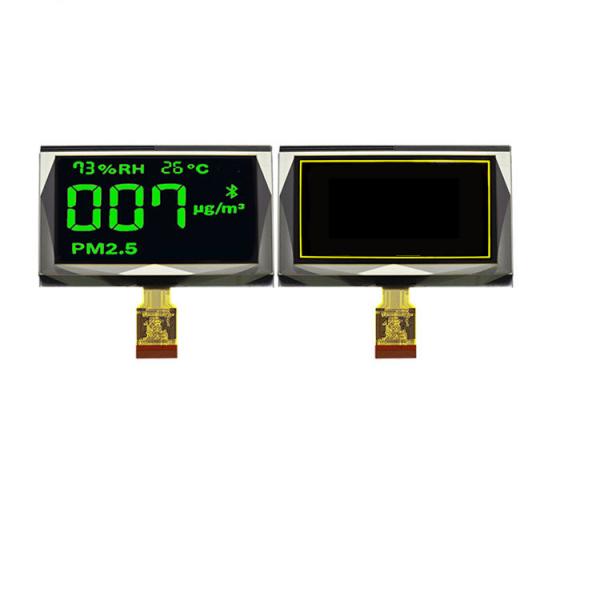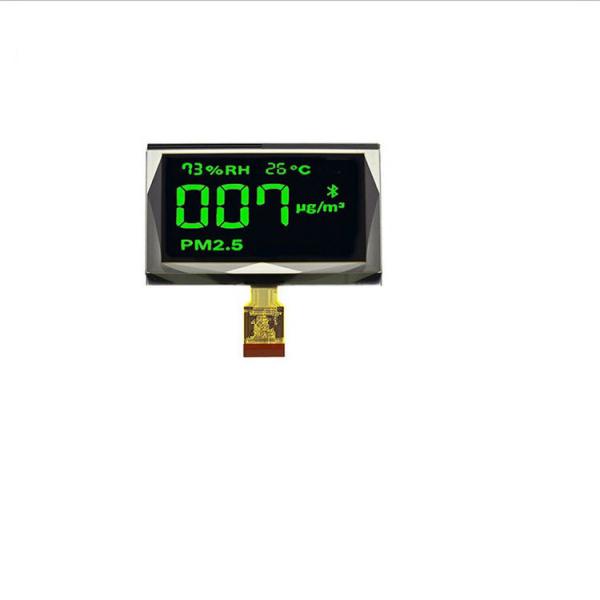- Home
- Products
- About Us
- Quality Control
- Contact Us
- Get Quotations
Brand Name : HuaXin
Model Number : ESHX240128-02
Certification : ISO14001/ISO9001/IATF16949
Place of Origin : China
MOQ : 1000pcs
Price : negotiation
Payment Terms : T/T
Supply Ability : 100K per month
Delivery Time : 6weeks~8weeks
Packaging Details : blister+foam box+bubble bag+inside carton+master carton
Display Technology : PMoled display
name : oled module
size : 3.37 "
resolution : 240*128
interface : 15 pins 3/4-wire SPI
driving IC : SSD1322
3.37 inch PMOLED display module , 240*128 Resolution, 15 pins 3/4-wire SPI interface, driving IC SSD1322,free view angle,connecting method is connector, operating tempature is -30~80,display color is yellow or green
A:Product Parameter
| Part NO. | ESHX240128-02 |
| Display Technology | PMOLED |
| Diagonal Screen Size | 3.37 inch |
| Resolution | 240*128 |
| Viewing Angle | free |
| Active Area (mm) | 77.58x42.3mm |
| Module Size(mm) | 89.52*54.41*2.05 |
| Pixel pitch | 0.315x0.315 |
| Pixel size | 0.29x0.29 |
| Operation Temp | -30~80 |
| display color | yellow/green |
| Interface | 3/4-wire SPI |
| Pin q'ty | 15 PINS |
| driving IC | SSD1322 |
| Connecting method | connector |
B:Product Picture


C:Drawing

D: Oled Product Knowledge
OLED Advantages:
OLED sets are lighter and thinner than LCDs , high contrast, high color saturation, lower consumption
OLED Disadvantages
AMOLED is extremely expensive than LCD and TFT, lifetime is shorter than LCD and TFT
E: Company Information
Huaxin Advantage:
1. factory base located at inland city which has cost effective
2. most advanced new equipment which can keep quality stable
3. most processes using fully automatic equipment which has effeciency and stable quality
4. professional engineers and production leaders who works in lcd field for more than 20 years
5. self design for customized product
our certificates
1.ISO14001/
2.ISO9001/IATF16949
3.SGS of LCD module
F: Production Capacity
| Annual Production Capacity | 2021 (Current) | 2022 (Goal) | 2023 (Challenge) | 2024 (Challenge) | 2025 (Challenge) | Remark | ||
| LCD Producton Capacity | 4.5 | 9 | 9 | 9 | 9 | Unit:thousands of logarithms/Day | ||
| LCM Producton Capacity | 70 | 150 | 300 | 450 | 450 | Unit:Thousand piece/Day | ||
| Backlight Producton Capacity | 100 | 200 | 300 | 500 | 500 | Unit:Thousand piece/Day | ||
| OLED Producton Capacity | 10 | 20 | 30 | 40 | 50 | Unit:Thousand piece/Day | ||
G: Product Application
1.Wearable Devices
2. Portable Audio Players
3. Thermostats and Home Automation Devices
4. Car Dashboards and Instrument Clusters
5. Medical Device
6.Consumer Electronics
7. Industrial and Professional equipment
H:PMOLED Characteristics
1.Display Structure: PMOLED displays consist of an array of organic light-emitting diodes (OLEDs) arranged in rows and columns. Each OLED acts as a single pixel and emits light independently.
2.Passive Matrix: PMOLEDs use a passive matrix addressing scheme, where each row and column intersection in the display matrix is controlled by a driving circuit. This circuit applies voltage to the selected pixels to activate them.
3. High Contrast and Color Saturation:PMOLED displays offer high contrast ratios and vibrant colors. Since each pixel emits its own light, PMOLEDs can achieve deep blacks and vibrant colors without the need for a backlight.
4. Power Efficiency: PMOLED displays are generally power-efficient. They consume power only for the pixels that are active, as OLEDs emit light when a voltage is applied to them. In contrast, LCD displays require a backlight that consumes constant power regardless of the content being displayed.
5.Thin and Flexible: PMOLED displays are relatively thin and can be manufactured on flexible substrates. This makes them suitable for applications where flexibility or bendability is desired, such as curved displays or wearable devices.
6. Limited Resolution and Size: PMOLED technology has certain limitations compared to other display technologies. PMOLED displays are typically limited in resolution, and their pixel densities are lower compared to active matrix OLED (AMOLED) or LCD displays. Additionally, PMOLED displays are more suitable for smaller-sized screens due to manufacturing constraints.
7. Screen Persistence: PMOLED displays are susceptible to a phenomenon called screen persistence or burn-in, where prolonged display of static images can result in image retention or permanent damage to the display. However, technological advancements have mitigated this issue to a great extent in modern PMOLED displays.
I: What are the advantages of AMOLED displays compared to PMOLED displays?
1.Higher Resolution: AMOLED displays generally have higher pixel densities and resolutions compared to PMOLED displays. This means that AMOLED screens can provide sharper and more detailed images.
2. Better Color Reproduction: AMOLED displays typically offer more accurate and vibrant color reproduction. They can produce a wider color gamut, resulting in more vivid and lifelike images.
3. Faster Refresh Rates: AMOLED displays have faster response times and higher refresh rates compared to PMOLED displays. This makes them better suited for displaying fast-moving content, such as videos or animations, without motion blur or ghosting.
4. Improved Power Efficiency :Although both AMOLED and PMOLED displays are power-efficient compared to LCD displays, AMOLED technology has made significant advancements in power efficiency. AMOLED displays consume less power when displaying dark or black content because each pixel emits its own light and can be individually turned off.
5. Larger Screen Sizes: AMOLED technology enables the production of larger displays compared to PMOLED technology. AMOLED screens can be manufactured in larger sizes without compromising image quality or introducing significant performance issues.
6. Flexibility and Curved Displays: AMOLED displays can be manufactured on flexible substrates, allowing for curved or flexible screens. This flexibility opens up design possibilities for devices with unique form factors, such as curved smartphones or wearable devices.
|
|
3.37 Inch PMOLED Display Module , 240*128 Resolution, 15 Pins 3/4-Wire SPI Interface, Driving IC SSD1322 Images |